Comparative Analysis of The Book Thief and To Kill a Mockingbird
VerifiedAdded on 2023/06/10
|9
|2596
|196
AI Summary
This study conducts a thorough comparative analysis of Markus Zusak’s ‘The Book Thief’ and Harper Lee’s ‘To Kill a Mockingbird’ from different angles including context, target audience, genre, themes, language features and stylistic techniques.
Contribute Materials
Your contribution can guide someone’s learning journey. Share your
documents today.
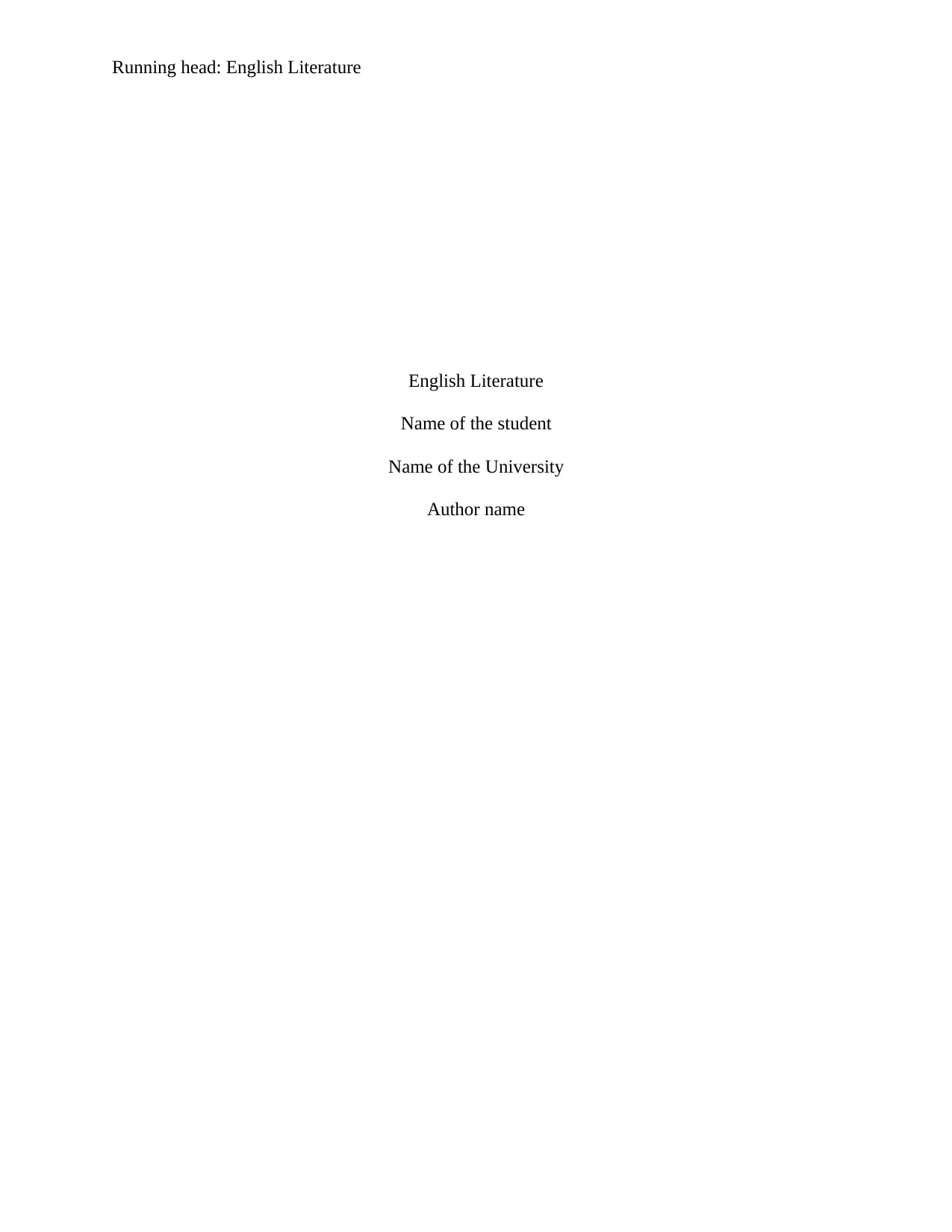
Running head: English Literature
English Literature
Name of the student
Name of the University
Author name
English Literature
Name of the student
Name of the University
Author name
Secure Best Marks with AI Grader
Need help grading? Try our AI Grader for instant feedback on your assignments.
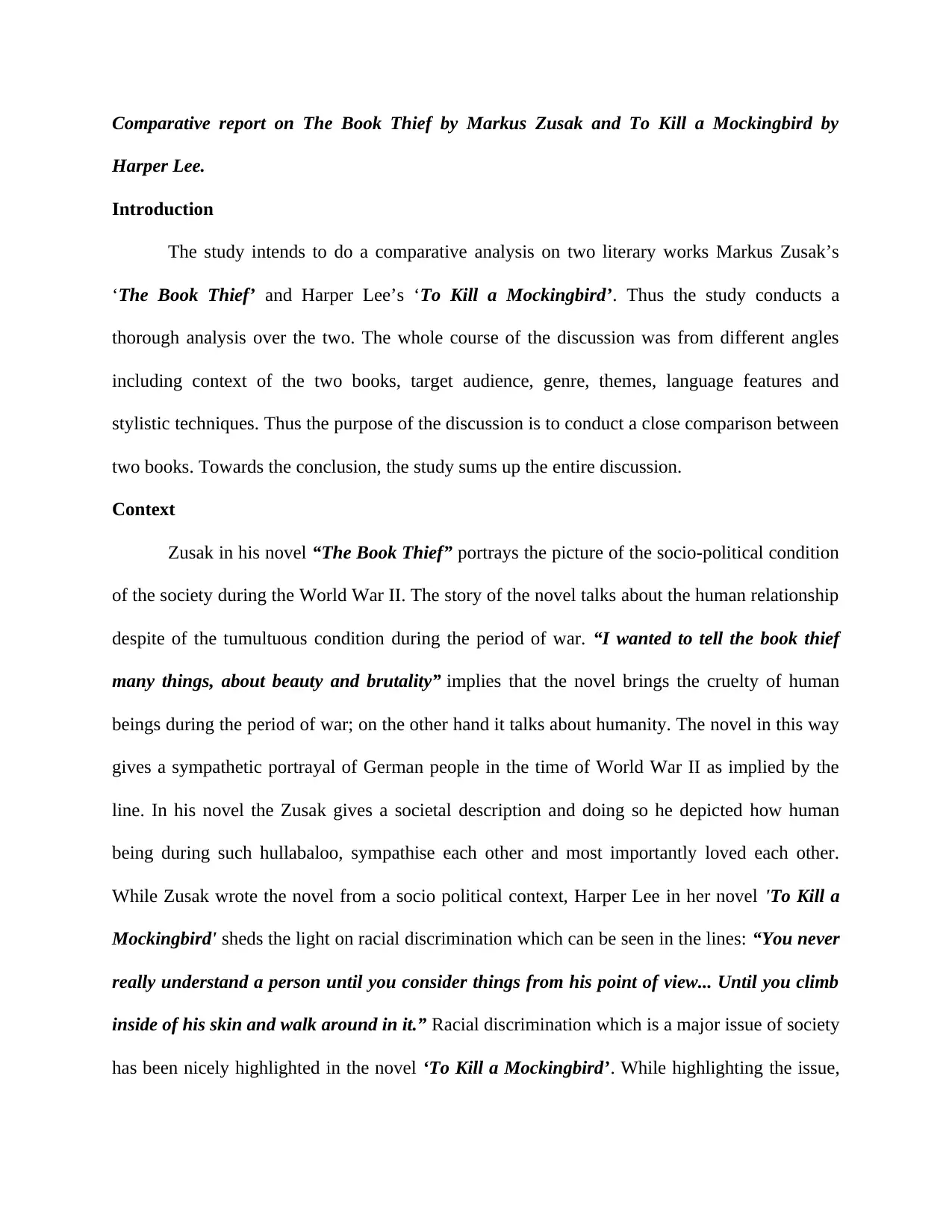
Comparative report on The Book Thief by Markus Zusak and To Kill a Mockingbird by
Harper Lee.
Introduction
The study intends to do a comparative analysis on two literary works Markus Zusak’s
‘The Book Thief’ and Harper Lee’s ‘To Kill a Mockingbird’. Thus the study conducts a
thorough analysis over the two. The whole course of the discussion was from different angles
including context of the two books, target audience, genre, themes, language features and
stylistic techniques. Thus the purpose of the discussion is to conduct a close comparison between
two books. Towards the conclusion, the study sums up the entire discussion.
Context
Zusak in his novel “The Book Thief” portrays the picture of the socio-political condition
of the society during the World War II. The story of the novel talks about the human relationship
despite of the tumultuous condition during the period of war. “I wanted to tell the book thief
many things, about beauty and brutality” implies that the novel brings the cruelty of human
beings during the period of war; on the other hand it talks about humanity. The novel in this way
gives a sympathetic portrayal of German people in the time of World War II as implied by the
line. In his novel the Zusak gives a societal description and doing so he depicted how human
being during such hullabaloo, sympathise each other and most importantly loved each other.
While Zusak wrote the novel from a socio political context, Harper Lee in her novel 'To Kill a
Mockingbird' sheds the light on racial discrimination which can be seen in the lines: “You never
really understand a person until you consider things from his point of view... Until you climb
inside of his skin and walk around in it.” Racial discrimination which is a major issue of society
has been nicely highlighted in the novel ‘To Kill a Mockingbird’. While highlighting the issue,
Harper Lee.
Introduction
The study intends to do a comparative analysis on two literary works Markus Zusak’s
‘The Book Thief’ and Harper Lee’s ‘To Kill a Mockingbird’. Thus the study conducts a
thorough analysis over the two. The whole course of the discussion was from different angles
including context of the two books, target audience, genre, themes, language features and
stylistic techniques. Thus the purpose of the discussion is to conduct a close comparison between
two books. Towards the conclusion, the study sums up the entire discussion.
Context
Zusak in his novel “The Book Thief” portrays the picture of the socio-political condition
of the society during the World War II. The story of the novel talks about the human relationship
despite of the tumultuous condition during the period of war. “I wanted to tell the book thief
many things, about beauty and brutality” implies that the novel brings the cruelty of human
beings during the period of war; on the other hand it talks about humanity. The novel in this way
gives a sympathetic portrayal of German people in the time of World War II as implied by the
line. In his novel the Zusak gives a societal description and doing so he depicted how human
being during such hullabaloo, sympathise each other and most importantly loved each other.
While Zusak wrote the novel from a socio political context, Harper Lee in her novel 'To Kill a
Mockingbird' sheds the light on racial discrimination which can be seen in the lines: “You never
really understand a person until you consider things from his point of view... Until you climb
inside of his skin and walk around in it.” Racial discrimination which is a major issue of society
has been nicely highlighted in the novel ‘To Kill a Mockingbird’. While highlighting the issue,

Lee focuses on describing how the issue affects a human being who is to face discriminative
attitude from society.
Target audience and purpose
Both of the two novels have been penned down aiming to attract the attention of the
young adults. However, they are not limited to only that range of audience. Both of the novels
have been able to achieve popularity among the readers of all age groups. Lee wrote the novel
more than fifty years ago but it still holds relevancy in the present days. The novel has secured a
place among the school studies due to its moral and cultural significance. At the same time, at
the first glance it seems that the target audience of the novel ‘The Book Thief’ is the young
adults of German society. However, the novel’s author’s presentation of the then societal
condition was not only for the young adults of German society but it is written for a wider
audience base. Rather it can be said that the writer’s portrayal of humanity during World War II
is to the world. Through his novel Zusak attempted to shed light on how love, humanity can take
over cruelty whereas Lee’s attempt to write the novel ‘To Kill a Mockingbird’ intended to create
awareness among the readers regrading the ill practices in the society.
Genre conventions
Lee’s novel ‘To Kill a Mocking Bird’ which depicts the racial discrimination in society
falls under the genre of southern gothic fiction. The events of the story take place in South while
it includes the dark aspects of the society. Meanwhile, the story also consists of comic elements.
The most significant feature of the Southern gothic is the presence of supernatural element which
is seen to be present in the novel. For instance, the role of the ghost played in the novel 'To Kill a
Mockingbird' by one of the most important character Boo Radley. His name as well as his
attitude from society.
Target audience and purpose
Both of the two novels have been penned down aiming to attract the attention of the
young adults. However, they are not limited to only that range of audience. Both of the novels
have been able to achieve popularity among the readers of all age groups. Lee wrote the novel
more than fifty years ago but it still holds relevancy in the present days. The novel has secured a
place among the school studies due to its moral and cultural significance. At the same time, at
the first glance it seems that the target audience of the novel ‘The Book Thief’ is the young
adults of German society. However, the novel’s author’s presentation of the then societal
condition was not only for the young adults of German society but it is written for a wider
audience base. Rather it can be said that the writer’s portrayal of humanity during World War II
is to the world. Through his novel Zusak attempted to shed light on how love, humanity can take
over cruelty whereas Lee’s attempt to write the novel ‘To Kill a Mockingbird’ intended to create
awareness among the readers regrading the ill practices in the society.
Genre conventions
Lee’s novel ‘To Kill a Mocking Bird’ which depicts the racial discrimination in society
falls under the genre of southern gothic fiction. The events of the story take place in South while
it includes the dark aspects of the society. Meanwhile, the story also consists of comic elements.
The most significant feature of the Southern gothic is the presence of supernatural element which
is seen to be present in the novel. For instance, the role of the ghost played in the novel 'To Kill a
Mockingbird' by one of the most important character Boo Radley. His name as well as his
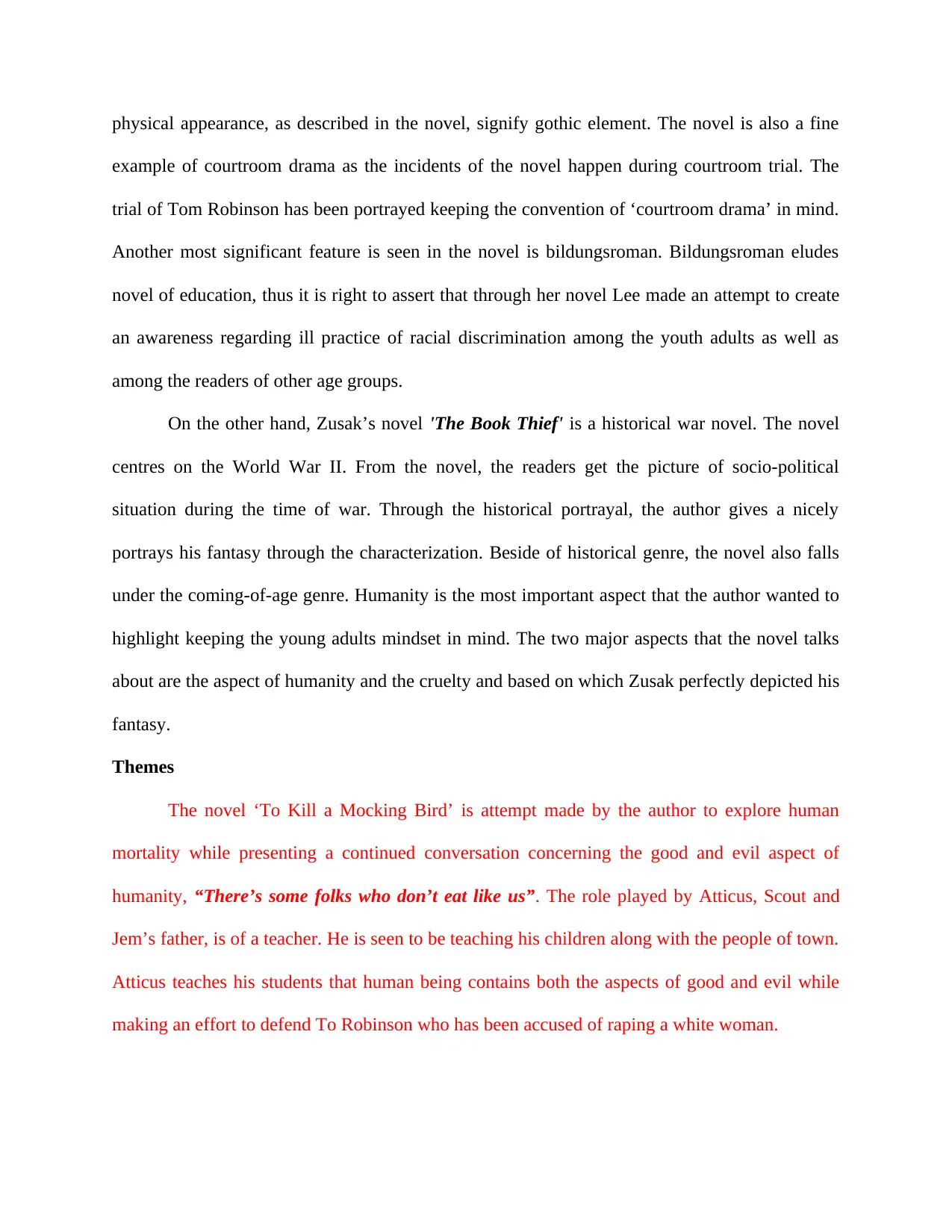
physical appearance, as described in the novel, signify gothic element. The novel is also a fine
example of courtroom drama as the incidents of the novel happen during courtroom trial. The
trial of Tom Robinson has been portrayed keeping the convention of ‘courtroom drama’ in mind.
Another most significant feature is seen in the novel is bildungsroman. Bildungsroman eludes
novel of education, thus it is right to assert that through her novel Lee made an attempt to create
an awareness regarding ill practice of racial discrimination among the youth adults as well as
among the readers of other age groups.
On the other hand, Zusak’s novel 'The Book Thief' is a historical war novel. The novel
centres on the World War II. From the novel, the readers get the picture of socio-political
situation during the time of war. Through the historical portrayal, the author gives a nicely
portrays his fantasy through the characterization. Beside of historical genre, the novel also falls
under the coming-of-age genre. Humanity is the most important aspect that the author wanted to
highlight keeping the young adults mindset in mind. The two major aspects that the novel talks
about are the aspect of humanity and the cruelty and based on which Zusak perfectly depicted his
fantasy.
Themes
The novel ‘To Kill a Mocking Bird’ is attempt made by the author to explore human
mortality while presenting a continued conversation concerning the good and evil aspect of
humanity, “There’s some folks who don’t eat like us”. The role played by Atticus, Scout and
Jem’s father, is of a teacher. He is seen to be teaching his children along with the people of town.
Atticus teaches his students that human being contains both the aspects of good and evil while
making an effort to defend To Robinson who has been accused of raping a white woman.
example of courtroom drama as the incidents of the novel happen during courtroom trial. The
trial of Tom Robinson has been portrayed keeping the convention of ‘courtroom drama’ in mind.
Another most significant feature is seen in the novel is bildungsroman. Bildungsroman eludes
novel of education, thus it is right to assert that through her novel Lee made an attempt to create
an awareness regarding ill practice of racial discrimination among the youth adults as well as
among the readers of other age groups.
On the other hand, Zusak’s novel 'The Book Thief' is a historical war novel. The novel
centres on the World War II. From the novel, the readers get the picture of socio-political
situation during the time of war. Through the historical portrayal, the author gives a nicely
portrays his fantasy through the characterization. Beside of historical genre, the novel also falls
under the coming-of-age genre. Humanity is the most important aspect that the author wanted to
highlight keeping the young adults mindset in mind. The two major aspects that the novel talks
about are the aspect of humanity and the cruelty and based on which Zusak perfectly depicted his
fantasy.
Themes
The novel ‘To Kill a Mocking Bird’ is attempt made by the author to explore human
mortality while presenting a continued conversation concerning the good and evil aspect of
humanity, “There’s some folks who don’t eat like us”. The role played by Atticus, Scout and
Jem’s father, is of a teacher. He is seen to be teaching his children along with the people of town.
Atticus teaches his students that human being contains both the aspects of good and evil while
making an effort to defend To Robinson who has been accused of raping a white woman.
Secure Best Marks with AI Grader
Need help grading? Try our AI Grader for instant feedback on your assignments.
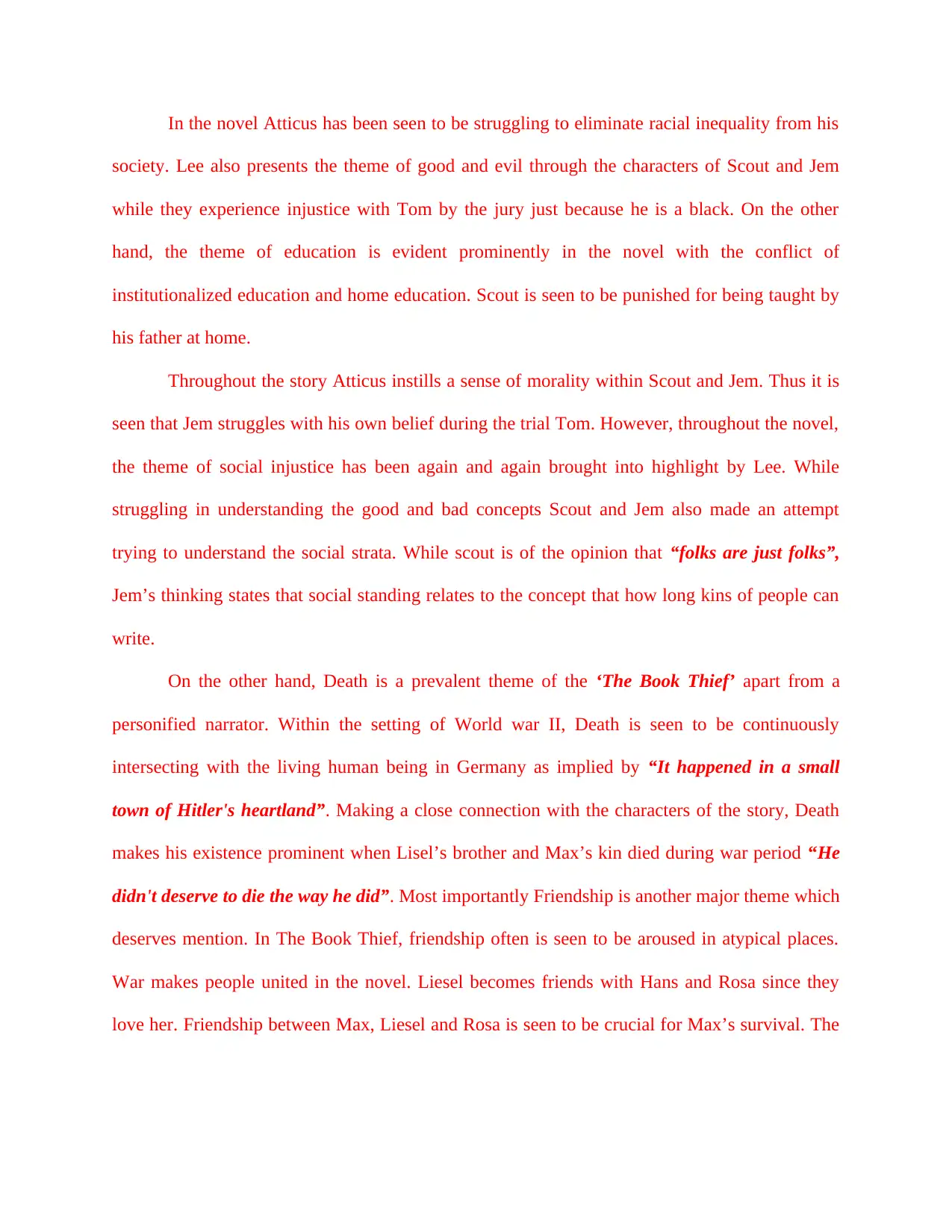
In the novel Atticus has been seen to be struggling to eliminate racial inequality from his
society. Lee also presents the theme of good and evil through the characters of Scout and Jem
while they experience injustice with Tom by the jury just because he is a black. On the other
hand, the theme of education is evident prominently in the novel with the conflict of
institutionalized education and home education. Scout is seen to be punished for being taught by
his father at home.
Throughout the story Atticus instills a sense of morality within Scout and Jem. Thus it is
seen that Jem struggles with his own belief during the trial Tom. However, throughout the novel,
the theme of social injustice has been again and again brought into highlight by Lee. While
struggling in understanding the good and bad concepts Scout and Jem also made an attempt
trying to understand the social strata. While scout is of the opinion that “folks are just folks”,
Jem’s thinking states that social standing relates to the concept that how long kins of people can
write.
On the other hand, Death is a prevalent theme of the ‘The Book Thief’ apart from a
personified narrator. Within the setting of World war II, Death is seen to be continuously
intersecting with the living human being in Germany as implied by “It happened in a small
town of Hitler's heartland”. Making a close connection with the characters of the story, Death
makes his existence prominent when Lisel’s brother and Max’s kin died during war period “He
didn't deserve to die the way he did”. Most importantly Friendship is another major theme which
deserves mention. In The Book Thief, friendship often is seen to be aroused in atypical places.
War makes people united in the novel. Liesel becomes friends with Hans and Rosa since they
love her. Friendship between Max, Liesel and Rosa is seen to be crucial for Max’s survival. The
society. Lee also presents the theme of good and evil through the characters of Scout and Jem
while they experience injustice with Tom by the jury just because he is a black. On the other
hand, the theme of education is evident prominently in the novel with the conflict of
institutionalized education and home education. Scout is seen to be punished for being taught by
his father at home.
Throughout the story Atticus instills a sense of morality within Scout and Jem. Thus it is
seen that Jem struggles with his own belief during the trial Tom. However, throughout the novel,
the theme of social injustice has been again and again brought into highlight by Lee. While
struggling in understanding the good and bad concepts Scout and Jem also made an attempt
trying to understand the social strata. While scout is of the opinion that “folks are just folks”,
Jem’s thinking states that social standing relates to the concept that how long kins of people can
write.
On the other hand, Death is a prevalent theme of the ‘The Book Thief’ apart from a
personified narrator. Within the setting of World war II, Death is seen to be continuously
intersecting with the living human being in Germany as implied by “It happened in a small
town of Hitler's heartland”. Making a close connection with the characters of the story, Death
makes his existence prominent when Lisel’s brother and Max’s kin died during war period “He
didn't deserve to die the way he did”. Most importantly Friendship is another major theme which
deserves mention. In The Book Thief, friendship often is seen to be aroused in atypical places.
War makes people united in the novel. Liesel becomes friends with Hans and Rosa since they
love her. Friendship between Max, Liesel and Rosa is seen to be crucial for Max’s survival. The
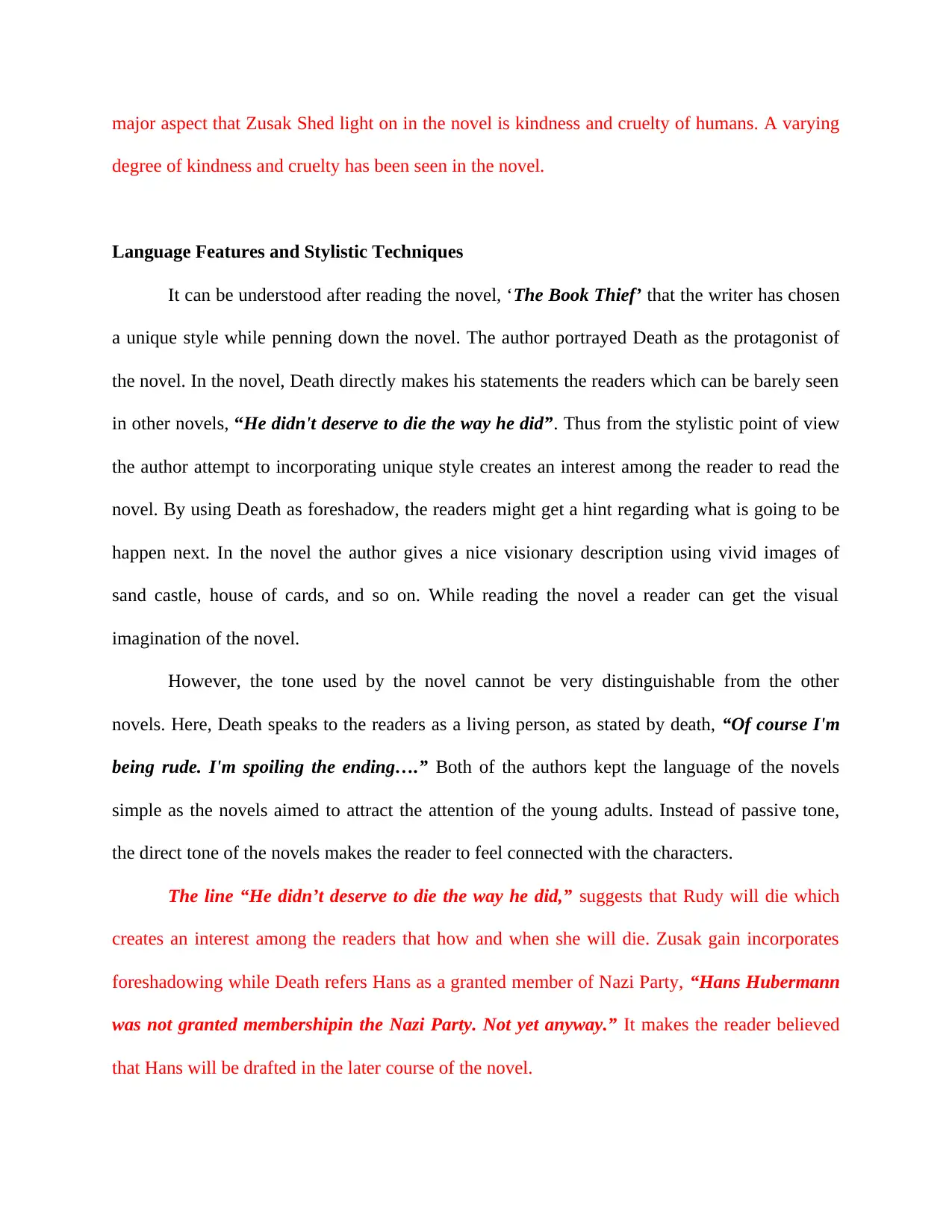
major aspect that Zusak Shed light on in the novel is kindness and cruelty of humans. A varying
degree of kindness and cruelty has been seen in the novel.
Language Features and Stylistic Techniques
It can be understood after reading the novel, ‘The Book Thief’ that the writer has chosen
a unique style while penning down the novel. The author portrayed Death as the protagonist of
the novel. In the novel, Death directly makes his statements the readers which can be barely seen
in other novels, “He didn't deserve to die the way he did”. Thus from the stylistic point of view
the author attempt to incorporating unique style creates an interest among the reader to read the
novel. By using Death as foreshadow, the readers might get a hint regarding what is going to be
happen next. In the novel the author gives a nice visionary description using vivid images of
sand castle, house of cards, and so on. While reading the novel a reader can get the visual
imagination of the novel.
However, the tone used by the novel cannot be very distinguishable from the other
novels. Here, Death speaks to the readers as a living person, as stated by death, “Of course I'm
being rude. I'm spoiling the ending….” Both of the authors kept the language of the novels
simple as the novels aimed to attract the attention of the young adults. Instead of passive tone,
the direct tone of the novels makes the reader to feel connected with the characters.
The line “He didn’t deserve to die the way he did,” suggests that Rudy will die which
creates an interest among the readers that how and when she will die. Zusak gain incorporates
foreshadowing while Death refers Hans as a granted member of Nazi Party, “Hans Hubermann
was not granted membershipin the Nazi Party. Not yet anyway.” It makes the reader believed
that Hans will be drafted in the later course of the novel.
degree of kindness and cruelty has been seen in the novel.
Language Features and Stylistic Techniques
It can be understood after reading the novel, ‘The Book Thief’ that the writer has chosen
a unique style while penning down the novel. The author portrayed Death as the protagonist of
the novel. In the novel, Death directly makes his statements the readers which can be barely seen
in other novels, “He didn't deserve to die the way he did”. Thus from the stylistic point of view
the author attempt to incorporating unique style creates an interest among the reader to read the
novel. By using Death as foreshadow, the readers might get a hint regarding what is going to be
happen next. In the novel the author gives a nice visionary description using vivid images of
sand castle, house of cards, and so on. While reading the novel a reader can get the visual
imagination of the novel.
However, the tone used by the novel cannot be very distinguishable from the other
novels. Here, Death speaks to the readers as a living person, as stated by death, “Of course I'm
being rude. I'm spoiling the ending….” Both of the authors kept the language of the novels
simple as the novels aimed to attract the attention of the young adults. Instead of passive tone,
the direct tone of the novels makes the reader to feel connected with the characters.
The line “He didn’t deserve to die the way he did,” suggests that Rudy will die which
creates an interest among the readers that how and when she will die. Zusak gain incorporates
foreshadowing while Death refers Hans as a granted member of Nazi Party, “Hans Hubermann
was not granted membershipin the Nazi Party. Not yet anyway.” It makes the reader believed
that Hans will be drafted in the later course of the novel.
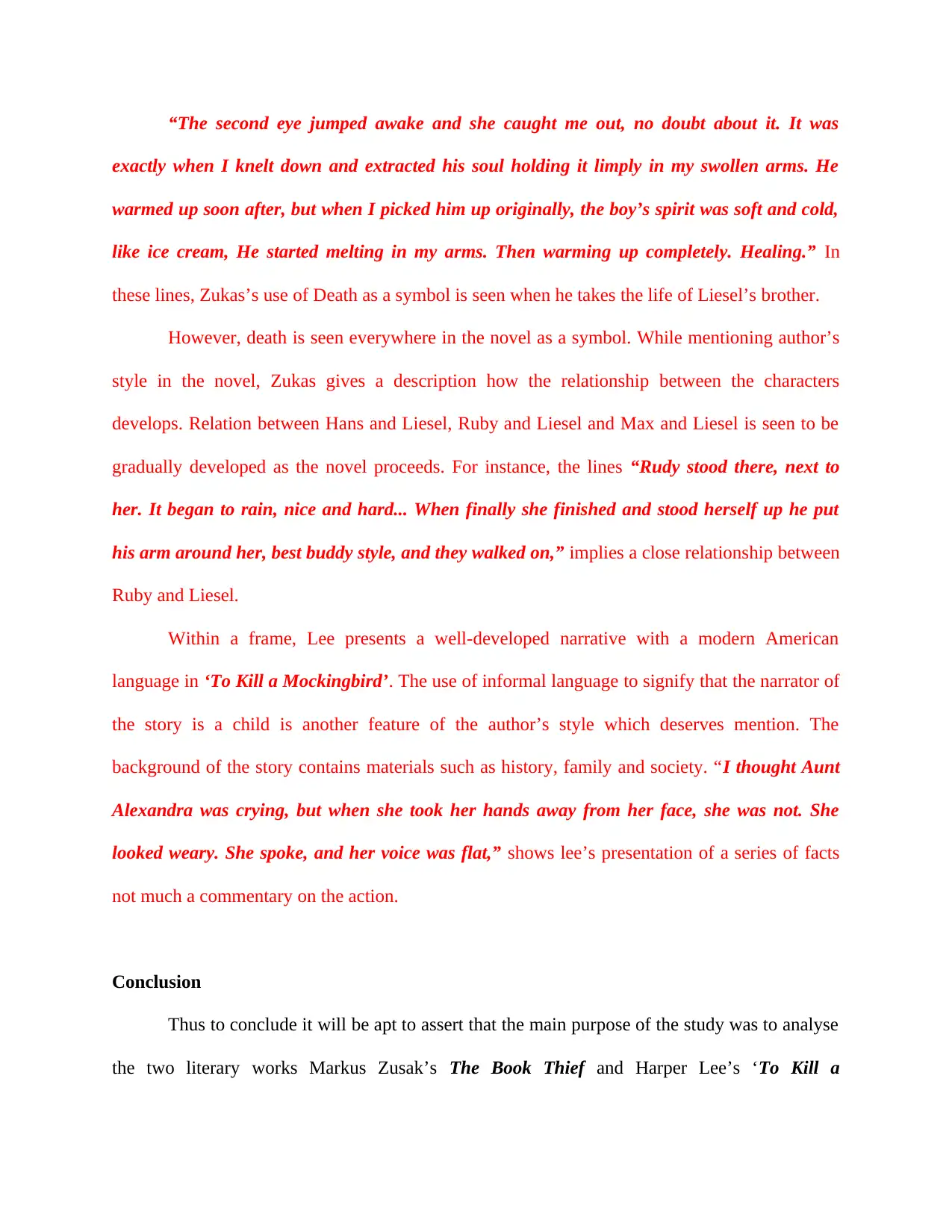
“The second eye jumped awake and she caught me out, no doubt about it. It was
exactly when I knelt down and extracted his soul holding it limply in my swollen arms. He
warmed up soon after, but when I picked him up originally, the boy’s spirit was soft and cold,
like ice cream, He started melting in my arms. Then warming up completely. Healing.” In
these lines, Zukas’s use of Death as a symbol is seen when he takes the life of Liesel’s brother.
However, death is seen everywhere in the novel as a symbol. While mentioning author’s
style in the novel, Zukas gives a description how the relationship between the characters
develops. Relation between Hans and Liesel, Ruby and Liesel and Max and Liesel is seen to be
gradually developed as the novel proceeds. For instance, the lines “Rudy stood there, next to
her. It began to rain, nice and hard... When finally she finished and stood herself up he put
his arm around her, best buddy style, and they walked on,” implies a close relationship between
Ruby and Liesel.
Within a frame, Lee presents a well-developed narrative with a modern American
language in ‘To Kill a Mockingbird’. The use of informal language to signify that the narrator of
the story is a child is another feature of the author’s style which deserves mention. The
background of the story contains materials such as history, family and society. “I thought Aunt
Alexandra was crying, but when she took her hands away from her face, she was not. She
looked weary. She spoke, and her voice was flat,” shows lee’s presentation of a series of facts
not much a commentary on the action.
Conclusion
Thus to conclude it will be apt to assert that the main purpose of the study was to analyse
the two literary works Markus Zusak’s The Book Thief and Harper Lee’s ‘To Kill a
exactly when I knelt down and extracted his soul holding it limply in my swollen arms. He
warmed up soon after, but when I picked him up originally, the boy’s spirit was soft and cold,
like ice cream, He started melting in my arms. Then warming up completely. Healing.” In
these lines, Zukas’s use of Death as a symbol is seen when he takes the life of Liesel’s brother.
However, death is seen everywhere in the novel as a symbol. While mentioning author’s
style in the novel, Zukas gives a description how the relationship between the characters
develops. Relation between Hans and Liesel, Ruby and Liesel and Max and Liesel is seen to be
gradually developed as the novel proceeds. For instance, the lines “Rudy stood there, next to
her. It began to rain, nice and hard... When finally she finished and stood herself up he put
his arm around her, best buddy style, and they walked on,” implies a close relationship between
Ruby and Liesel.
Within a frame, Lee presents a well-developed narrative with a modern American
language in ‘To Kill a Mockingbird’. The use of informal language to signify that the narrator of
the story is a child is another feature of the author’s style which deserves mention. The
background of the story contains materials such as history, family and society. “I thought Aunt
Alexandra was crying, but when she took her hands away from her face, she was not. She
looked weary. She spoke, and her voice was flat,” shows lee’s presentation of a series of facts
not much a commentary on the action.
Conclusion
Thus to conclude it will be apt to assert that the main purpose of the study was to analyse
the two literary works Markus Zusak’s The Book Thief and Harper Lee’s ‘To Kill a
Paraphrase This Document
Need a fresh take? Get an instant paraphrase of this document with our AI Paraphraser
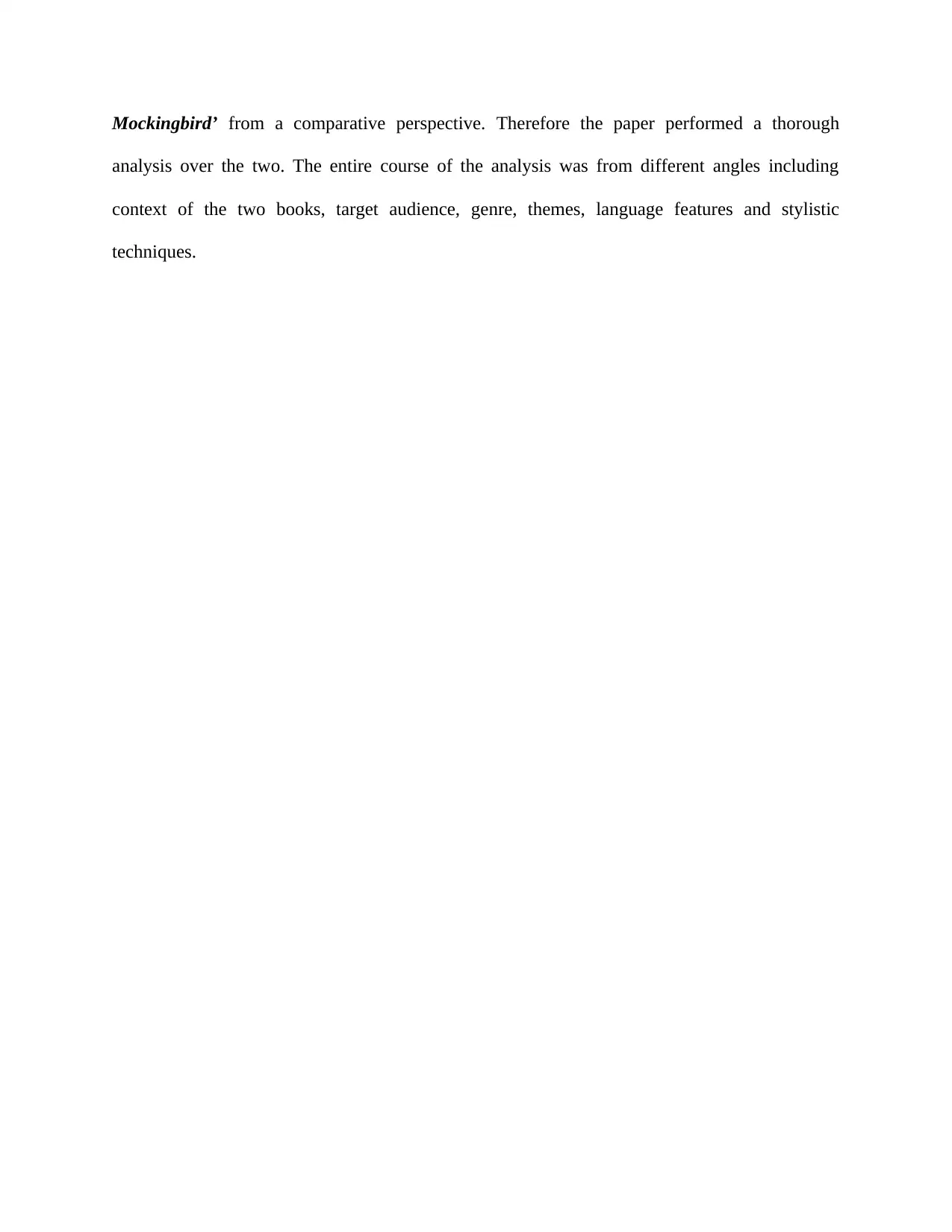
Mockingbird’ from a comparative perspective. Therefore the paper performed a thorough
analysis over the two. The entire course of the analysis was from different angles including
context of the two books, target audience, genre, themes, language features and stylistic
techniques.
analysis over the two. The entire course of the analysis was from different angles including
context of the two books, target audience, genre, themes, language features and stylistic
techniques.
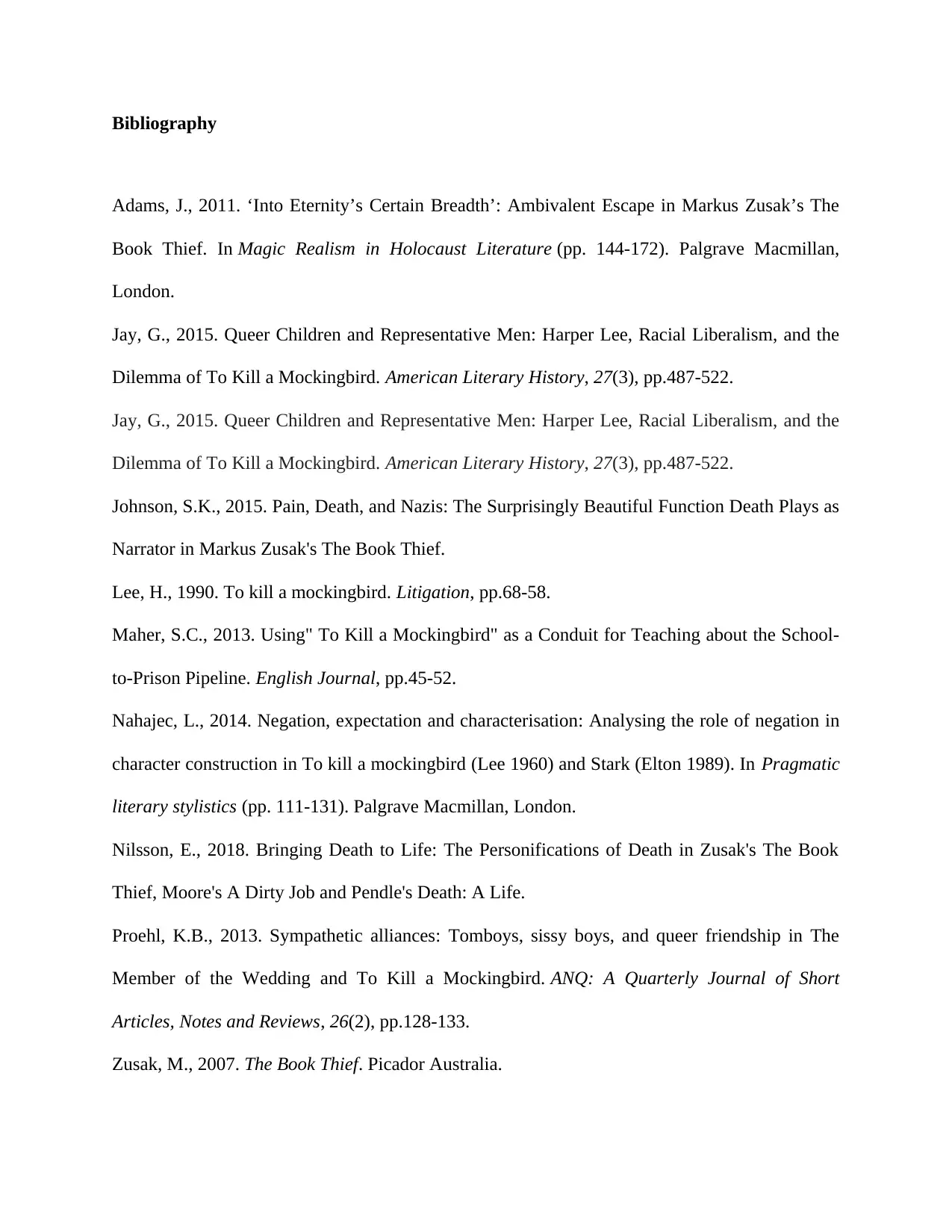
Bibliography
Adams, J., 2011. ‘Into Eternity’s Certain Breadth’: Ambivalent Escape in Markus Zusak’s The
Book Thief. In Magic Realism in Holocaust Literature (pp. 144-172). Palgrave Macmillan,
London.
Jay, G., 2015. Queer Children and Representative Men: Harper Lee, Racial Liberalism, and the
Dilemma of To Kill a Mockingbird. American Literary History, 27(3), pp.487-522.
Jay, G., 2015. Queer Children and Representative Men: Harper Lee, Racial Liberalism, and the
Dilemma of To Kill a Mockingbird. American Literary History, 27(3), pp.487-522.
Johnson, S.K., 2015. Pain, Death, and Nazis: The Surprisingly Beautiful Function Death Plays as
Narrator in Markus Zusak's The Book Thief.
Lee, H., 1990. To kill a mockingbird. Litigation, pp.68-58.
Maher, S.C., 2013. Using" To Kill a Mockingbird" as a Conduit for Teaching about the School-
to-Prison Pipeline. English Journal, pp.45-52.
Nahajec, L., 2014. Negation, expectation and characterisation: Analysing the role of negation in
character construction in To kill a mockingbird (Lee 1960) and Stark (Elton 1989). In Pragmatic
literary stylistics (pp. 111-131). Palgrave Macmillan, London.
Nilsson, E., 2018. Bringing Death to Life: The Personifications of Death in Zusak's The Book
Thief, Moore's A Dirty Job and Pendle's Death: A Life.
Proehl, K.B., 2013. Sympathetic alliances: Tomboys, sissy boys, and queer friendship in The
Member of the Wedding and To Kill a Mockingbird. ANQ: A Quarterly Journal of Short
Articles, Notes and Reviews, 26(2), pp.128-133.
Zusak, M., 2007. The Book Thief. Picador Australia.
Adams, J., 2011. ‘Into Eternity’s Certain Breadth’: Ambivalent Escape in Markus Zusak’s The
Book Thief. In Magic Realism in Holocaust Literature (pp. 144-172). Palgrave Macmillan,
London.
Jay, G., 2015. Queer Children and Representative Men: Harper Lee, Racial Liberalism, and the
Dilemma of To Kill a Mockingbird. American Literary History, 27(3), pp.487-522.
Jay, G., 2015. Queer Children and Representative Men: Harper Lee, Racial Liberalism, and the
Dilemma of To Kill a Mockingbird. American Literary History, 27(3), pp.487-522.
Johnson, S.K., 2015. Pain, Death, and Nazis: The Surprisingly Beautiful Function Death Plays as
Narrator in Markus Zusak's The Book Thief.
Lee, H., 1990. To kill a mockingbird. Litigation, pp.68-58.
Maher, S.C., 2013. Using" To Kill a Mockingbird" as a Conduit for Teaching about the School-
to-Prison Pipeline. English Journal, pp.45-52.
Nahajec, L., 2014. Negation, expectation and characterisation: Analysing the role of negation in
character construction in To kill a mockingbird (Lee 1960) and Stark (Elton 1989). In Pragmatic
literary stylistics (pp. 111-131). Palgrave Macmillan, London.
Nilsson, E., 2018. Bringing Death to Life: The Personifications of Death in Zusak's The Book
Thief, Moore's A Dirty Job and Pendle's Death: A Life.
Proehl, K.B., 2013. Sympathetic alliances: Tomboys, sissy boys, and queer friendship in The
Member of the Wedding and To Kill a Mockingbird. ANQ: A Quarterly Journal of Short
Articles, Notes and Reviews, 26(2), pp.128-133.
Zusak, M., 2007. The Book Thief. Picador Australia.
1 out of 9
Your All-in-One AI-Powered Toolkit for Academic Success.
+13062052269
info@desklib.com
Available 24*7 on WhatsApp / Email
![[object Object]](/_next/static/media/star-bottom.7253800d.svg)
Unlock your academic potential
© 2024 | Zucol Services PVT LTD | All rights reserved.
